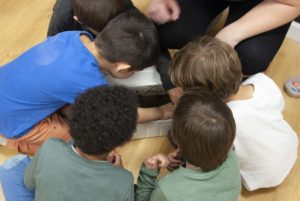“Tell me and I’ll forget. Show me and I will remember. Involve me and I will learn.”

The way we are taught determines how we retain and consolidate what we learn. With traditional methods, the learner is a passive subject in their own learning process. John Dewey, the prominent American educator, proposed that “if knowledge comes from the impressions that we have of ourselves, then we should be able to know what we know. natural objects do, it is impossible to obtain knowledge without the use of objects that impress the mind”. This approach has been the inspiration for the innovative English teaching method applied at FunTalk.
As children we learn by exploring our surroundings, and many of us continue to learn in this way. Babies do not learn from “tokens” or parental instructions, but from interacting with their environment and having enriching experiences. That is why it is so important in the teaching process to present the student, regardless of age, with situations in which they must take an active role in their learning. And by this we mean teaching through activities where the student must carry out actions or tasks with a certain purpose; in this way, learning is not a destination to be reached, but the road traveled.
This approach is called active learning and has proven to be a particularly effective teaching method, especially in language teaching. H.  W. Reese (2011), expounds that “languages are best learned by their use rather than by formal rules”. We can know all the grammatical rules of a language but if we do not apply it to authentic situations, we will not be able to use it as a communicative form. In addition, by engaging in activities where they can create things, use their hands, solve problems, etc., students are much more motivated (Owens, Sadler, Barlow, & Smith-Walters, 2017), which in turn positively affects attention and memory consolidation (Cavenagh, 2016).
W. Reese (2011), expounds that “languages are best learned by their use rather than by formal rules”. We can know all the grammatical rules of a language but if we do not apply it to authentic situations, we will not be able to use it as a communicative form. In addition, by engaging in activities where they can create things, use their hands, solve problems, etc., students are much more motivated (Owens, Sadler, Barlow, & Smith-Walters, 2017), which in turn positively affects attention and memory consolidation (Cavenagh, 2016).
For these reasons we are convinced that at FunTalk we have designed an effective, motivating and fun method for all ages to learn English in a memorable and meaningful way. Our dynamic classes offer students communicative contexts in which to learn and practice relevant language. And what makes us unique, our signature workshops, offer students opportunities to learn in real-life situations, not just English, but tools that they can then apply in other contexts in their lives.

In short, our students are happy because they learn in a natural and meaningful way. In addition, our youngest students come with enthusiasm because they do not come to sit in front of a book but to talk, play, create, think, reflect and develop their skills; and parents appreciate that! We are grateful to be able to share our vision with so many families and to see the progress of all our students over time.
Bibliography:
https://cei.umn.edu/active-learning
http://parklandplayers.com/hands-on-learning-what-does-it-mean-and-why-is-it-important/
http://www.communityplaythings.com/resources/articles/2017/hands-on-learning
Reese, H. W. (2011). The learning-by-doing principle. Behavioral Development Bulletin, 17(1), 1-19.

